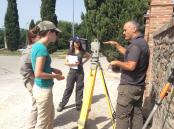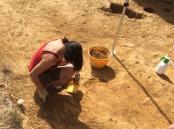CAMPAGNA 2014 |
1° SETTIMANA |
2° SETTIMANA |
3° SETTIMANA |
4° SETTIMANA |
5° SETTIMANA |
6° SETTIMANA |
7° SETTIMANA |
8° SETTIMANA |
24 GIUGNO 2014 
Resoconto della giornata di scavo
Area 2000
Dopo l'apertura e la pulizia generale dell'Area, effettuata ieri, è stato possibile identificare e mettere in luce alcune evidenze e situazioni stratigrafiche interessanti in entrambi i settori.
Nel Settore A l'attenzione è stata rivolta, in particolar modo, alla struttura laterizia USM 2100 dove all'interno sono emersi cinque tagli: due di questi sono orientati Nord Sud e sono intercettati sia sul lato settentrionale che meridionale da altri due tagli i quali presentano un orientamento opposto (Est Ovest), hanno un forma molto allungata e regolare e sono allineati tra loro; il quinto taglio è orientato NE/SO ed è collocato nella porzione più occidentale. E' possibile che si tratti di fosse sepolcrali che sfruttano lo spazio della vasca, come già documentato nelle scorse campagne di scavo. E' inoltre iniziata la rimozione dello strato principale US 2145 sul quale insistevano tutte le sepolture Settecentesche e Ottocentesche fin'ora individuate.
Nel Settore B si è proceduto alla documentazione e allo scavo dei due tagli (US -2388 e US-2393) individuati la scorsa campagna di scavo nella porzione centro occidentale dell'area; entrambi sono interrotti da due fosse sepolcrali legate alla fase del colera. US -2388 è quasi sicuramente afferente a fasi più antiche in quanto in sezione è visibile l'individuo in connessione (Usk 2389) il quale prosegue al di sotto del muro USM 2106 di epoca medioevale.
Nella porzione Nord orientale, invece, è emerso un ulteriore taglio sepolcrale (US-2395) che può essere legato all'epidemia del colera del 1855 grazie ad alcuni elementi certi: la fossa è allineata con precisione alle altre indagate lo scorso anno, il materiale ceramico rinvenuto nel riempimento è datato alla metà dell'Ottocento ed è presente uno strato di calce a diretto contatto con l'individuo (Usk 2399) qui deposto.
Domani è previsto l'allargamento dell'area verso Ovest.
Today we continued to define the level within 2000 section A using pickaxes and trowels. The level consisted of yellow brown loose silty clay. There were three distinct possible features. These features were a concentration of large rocks in the NW corner, and darker stains in the SE corners. These features will be further defined and examined tomorrow. A dark feature stain in the SE corner within the brick structure was defined and in the process of being excavated. No material culture was excavated. In section B three features were defined along the western boundary. One possible feature intersects two previously excavated cholera burials and runs west to east. From this possible feature a metal nail and some bone fragments were removed. Another feature cuts across one of the previously excavated cholera graves on the eastern side of sector B. The feature is located above the known location of human remains. The fill of the feature contains loose gravel, natural charcoal and chalk, and brick and mortar remnants. A femur and tibia are exposed. The final feature discovered in section B was a grave oriented north-south at the north boundary of section B. The grave orientation correlated to previously excavated cholera graves and the fill contained lime, both of which suggest the grave is a cholera grave. The fill was brown clay with striped with yellow streaks and contained fragments of brick, slate, rocks, and small sections of quartz material, as well as the aforementioned lime. The skull was exposed about 3 meters down and the nose bridge has collapsed slightly. The right eye socket and the maxilla, along with one tooth, are exposed. Excavators hope to discover more cholera burials in order to expand the collection of bodies and better understand the epidemic.
Area 3000
La pulizia generale dello strato superficiale dell'ampliamento dell'area ha permesso di individuare parte della porzione meridionale dell'antica facciata dell'abbazia, orientata N-S. Immediatamente ad ovest della struttura muraria suddetta, ancora in corso di scavo, sono stati messi in luce alcuni elementi litici di media pezzatura disposti l'uno vicino all'altro, a formare una sorta di filare parallelo alla facciata stessa: è possibile che si tratti di una cassa litica, sul modello delle altre tre individuate durante le campagne precedenti. L'effettiva presenza di tale tomba in muratura sarà verificata nei prossimi giorni. Nella porzione centrale dell'ampliamento, la rimozione del livello sottostante la posa dell'asfalto, ha messo in evidenza uno strato principalmente a matrice argillosa, di colore giallastro e di consistenza compatta, ricco di macerie e di ossa sparse, appartenenti ad alcuni individui i cui scheletri sono stati intercettati, ridotti o rimaneggiati durante i diversi cantieri allestiti per il restauro della chiesa e la realizzazione del parcheggio e della piazza circostante. Durante lo scavo sono stati inoltre rinvenuti alcuni oggetti votivi, come medagliette devozionali, alcuni grani di rosario e perfino un anello in bronzo di epoca settecentesca, che probabilmente costituivano parte del corredo funerario delle sepolture perturbate. Nei giorni seguenti si procederà con l'approfondimento dell'orizzonte cimiteriale settecentesco e con l'esposizione completa della facciata dell'antica abbazia medievale e della possibile tomba a cassa litica prospiciente ed appoggiata ad essa.
In area 3000, the morning began by leveling the ground via pick axe and shoveling. After the initial leveling, bones began to show, including numerous crania and various long bones. The majority of these burials were found in the southern portion of the abbey, in exception to the mandible found to the south of the current church door. Future excavation is expected to show more complete burials of the skeletons that were uncovered in the layer today. In addition to this finding, there were also numerous beads and religious, bronze medallions found in the center of the area near carpal bones. These medallions were most likely in relation to the burials, although they were scattered. Of the various individuals, one was found south to north oriented in the praying fashion. In addition, a medallion close to hand could be a possible burial good. From this evidence, various burial goods are expected, in relation to more complex burials. The layer over the lithic coffin, situated outside the southwestern edge of the original abbey, was further leveled until its sides were clearly exposed. South to the lithic coffin, a skull was found. South to the skull, two lines of stones perpendicular to the facade of the old abbey were exposed. Traces of paint came to light at the base of the northwestern corner of the facade of the original abbey
Area 4000
Con la giornata odierna è proseguita la pulizia dell'area dalle rimanenze dell'apertura avvenuta tramite mezzo meccanico. Nella porzione sud-occidentale è stato individuato un accumulo di calce con orientamento nord/sud che ulteriori indagini potranno verificare se si tratti o meno della rasatura di una struttura. Nella fascia settentrionale dell'area iniziano ad affiorare frammenti di ardesia di medie dimensioni, coerenti con gli affioramenti già individuati nell'area 5000 e nel settore A dell'area 4000. I materiali sinora raccolti confermano la cronologia di questi primi livelli sub-stradali al XVIII-XIX secolo, ma le indagini svolte nei vecchi settori dell'area confermano la presenza a pochi centimetri dal piano stradale, di stratificazioni afferenti a datazioni poi vicine alla vita del monastero.
Today at Field School Pozzeveri 2014, our group continued excavation for Area 4000. We made further progress in the attempted westward expansion of the site. In this clearing we discovered a lack of difference in structural integrity between Area 5000 and Area 4000 thus these groups will be working closely together to determine whether these areas are part of one discovery or separate entities. Using pick axes, shovels and trowels we cleared asphalt and concrete from the modern road layer. Underneath this asphalt we found multiple layers of slate, clay, and rock that we are currently studying but believe to be part of a medieval road. Today we found two bone fragments, multiple 18th century nails, and an abundant amount of pottery, much like our discoveries from yesterday. This leads us to believe that we may uncover more ancient burials similar to ones found in other Areas.
Area 5000
Procede la pulizia preliminare dell'area che sta mettendo in evidenza uno strato caratterizzato dalla presenza di lastre di ardesia poste orizzontalmente sul terreno, esteso nella porzione ovest e sud dell'area di scavo. È stata individuata, inoltre, la traccia realizzata in età contemporanea per l'inserimento di una tubatura. Questa intercetta lo strato di lastre di ardesia appena citato e la struttura muraria US 5003, proseguendo verso l'area 3000 a nord. Infine, la pulizia sistematica della cresta di rasatura del perimetrale sud della chiesa ci ha permesso di osservare una lacuna nel muro, riempita con deposito argilloso, laterizi e molte ossa sparse.
Today in Area 5000 we finished removing the remnants of the modern road, creating a superficial excavation surface and cut back the east wall. While doing this, we found painted pottery, nails and bone fragments; these are consistent with artifacts found in other disturbed areas on the façade of the church (Area 3000, 4000, and 5000). For the north wall feature, we continued to take it down to level where a section of wall appears to be missing. Within this feature, we exposed comingled human bones and ceramics under which we believe we will find a continuation of the wall. What we are referring to as the North wall is the northern edge of Area 5000 but when constructed it was the southern wall of the nave which was excavated in previous years in Area 3000. Later in the day, Area 5000 acquired an additional meter of ground to the south of our area and, moving forward, will excavate in conjunction with area 4000 as we believe they may contain continuous features. Finally, two slate features were found, one along the east wall and one in the southwest corner. Tomorrow we will determine if the slate features are separate or continuous under the superficial excavation surface

















